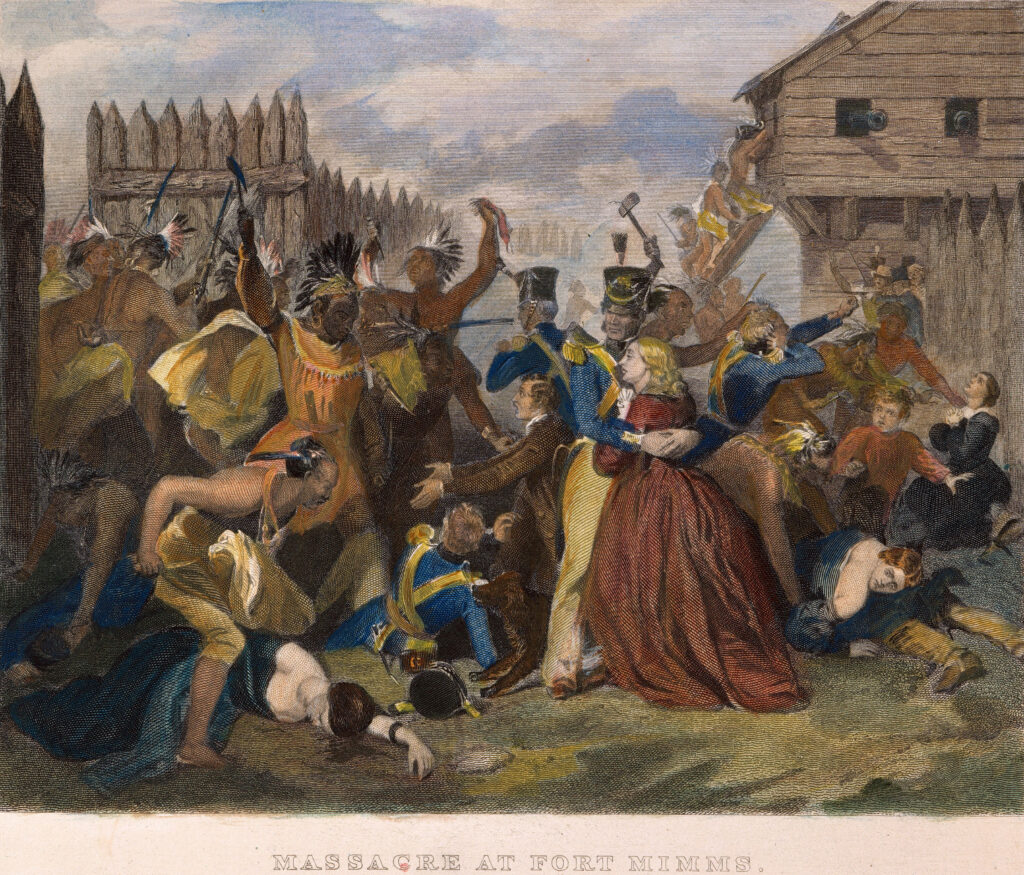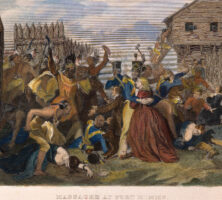Warfare affected the lives of Georgia’s Indians in many significant ways. All Indian men considered themselves warriors and trained to use the bow and war club. Valor in battle, demonstrated through the killing of enemies, was a primary means of social advancement as recently as the nineteenth century. Warfare also became a prominent theme in the Indians’ belief systems and greatly affected the development and organization of their societies.
Significant warfare first began to develop among Georgia Indians in the Mississippian Period (A.D. 800-1600), a time when relatively large societies called chiefdoms evolved throughout southeastern North America. During this period defensive fortifications were first built around some towns. These included log palisades that completely encircled large towns such as the one at the Etowah Mounds in north Georgia. Palisades were often plastered with clay to keep them from being ignited by burning arrows. Sometimes they incorporated defensive towers (bastions) that allowed archers to shoot at enemies who got close to the wall. Ditches similar to moats were also dug around some palisades and were part of the fortifications of both the Etowah site and the Ocmulgee site at Macon.
Weapons
Bows and arrows were widely used in Indian warfare beginning in the Late Woodland or Early Mississippian Period. Warriors used a thick D-shaped simple bow made from hickory, ash, or black locust that was fifty to sixty inches in length and had a pull weight of about fifty pounds. These bows could send arrows long distances and were typically used to shoot at enemy villages or units of warriors at a distance.
War clubs also came into significant use during the Mississippian Period. They were carved from a hardwood such as hickory and were usually about one-and-a-half to two feet long, although some may have reached three feet in length. There were several types, the most common form being the atassa, which was actually a wooden sword shaped like a pirate’s cutlass. Other common types were the globe-headed club, which had a three-inch spherical knob at the end of a slightly curved handle, and the tomahawk, a stone axe head attached to a wooden handle.
War clubs were the preferred combat weapon because Indian warriors could raise their social status by killing enemies in single combat. They were widely depicted in Mississippian Period art in association with images and symbols of warfare. In historic Creek and Cherokee myths they were associated with the Lightning or Thunder deity, sometimes in the form of a falcon.
Chiefs and warriors possessed ceremonial forms of war clubs that incorporated symbols of the Sun and Thunder deities and served as markers of their ceremonial status. These were made entirely from stone that had been chipped or ground into the desired shape, or alternatively, were tomahawks that had copper heads affixed to wooden handles.
Mississippian Period Warfare
Warriors honed their archery and warclub skills through lifelong training. According to early historical accounts, they demonstrated impressive skill in using war clubs and were favorably compared to European fencing masters. The warriors also played a lacrosse-type sport called “the ball game” in which they employed war club–sized ball sticks reminiscent of combat with war clubs.
The most common type of warfare was a raid carried out by a small group of men; a raiding party would surreptitiously enter an enemy chiefdom’s territory to attack unsuspecting households or ambush people. Warriors typically used war clubs in these raids. Trophies from the victims, such as scalps, were taken to prove their success in the encounter. In many Indian cultures the killing of one’s kinsman by an enemy necessitated reprisal. This could result in long-term, chronic raiding between enemy chiefdoms as each side in turn sought revenge on the other.
Historical accounts from the sixteenth and seventeenth centuries also describe a few large-scale battles between the armies of enemy chiefdoms. Each army consisted of a few hundred men arranged in a formation, with the chief acting as overall commander. They would shoot their arrows at one another until the supply was expended; then they would engage in hand-to-hand combat with war clubs.
Historic Period Warfare
Warfare changed dramatically during the eighteenth and nineteenth centuries as a result of European encroachment. Iron hatchets were extensively introduced in the early eighteenth century and began to replace war clubs. By the latter part of this century metal tomahawks were being made specifically for the Indian trade. Firearms had also been introduced.
Periodic raiding and some pitched battles continued between the Creek and Cherokee Indians in the Historic Period. By the late eighteenth and nineteenth centuries, both the Creeks and Cherokees faced increased military threats from white settlers who were able to raise large civilian militias equipped with firearms to reinforce military troops. The Indians were forced to cope with highly organized raids and battles with whites who had superior troops and equipment. The Indians adopted new military tactics, including larger armies to fight some pitched battles and guerrilla-style maneuvers. In some cases Indian communities erected forts styled after those of the whites. Ultimately, however, the Indians were unable to win against the superior numbers of well-armed American forces and were forcibly exiled to Oklahoma in the early nineteenth century.

Reprinted by permission of The Granger Collection, New York






